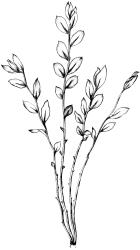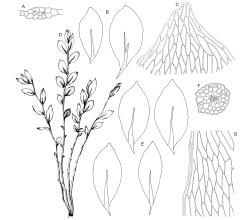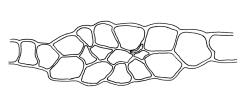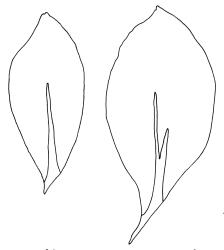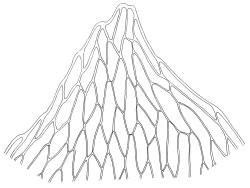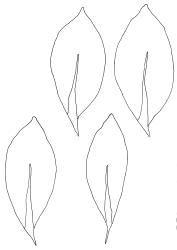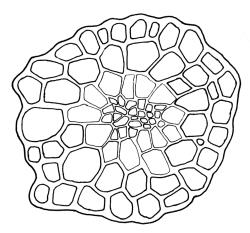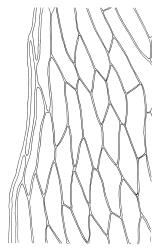- = Epipterygium obovatum Ochyra, Polish. Bot. Stud. 1: 52 (1991)
Plants very small, pale green or brownish green, strongly lustrous both fresh and dry, complanate. Stems pale yellowish or reddish brown, several arising from a common point, unbranched, to 15 mm tall, in cross‑section c. 180–210 μm diam., with a well‑defined central strand and 1–2 layers of thick‑walled cortical cells, beset with sparse, nearly smooth, yellow-brown rhizoids near base. Leaves distichously arranged, not dimorphic, somewhat asymmetric (especially at base), broadly elliptic from a narrow base, broadly acute at apex, 1.5–2.1 × 0.7–0.85 mm, becoming smaller and scale‑like towards the stem base; margins plane, entire or slightly crenulate, often with a few blunt teeth at the apex; upper laminal cells thin‑walled, prosenchymatous, (90–)120–180(–195) × (21–)24–30 μm, somewhat longer and obliquely arranged below, 1–2 rows at margins firmer‑walled, linear, c. 225–270 μm long, and forming a faint border most distinct at mid leaf. Costa ⅓–⅔ the leaf length, broad and ± diffuse at base, sometimes branched, in cross‑section with 2–3 layers of cells, weakly defined guide cells, and no stereids.
Apparently dioicous. Perichaetia terminal, with leaves somewhat narrower than vegetative leaves but not otherwise differentiated, with c. 5–8 archegonia and lacking paraphyses. Perigonia and sporophytes not seen.
Fife & Shaw 1990, figs 1–2; Ochyra 1991, figs 1–29 (as E. obovatum).
Confusion seems likely only with reduced plants of Cyathophorum bulbosum, which often occur on the root plates of wind-thrown trees. In such instances the presence of reduced ventral leaves, more acute lateral leaves, and the less lustrous plants of C. bulbosum are sufficient to distinguish it from E. opararense. Mittenia plumula, which is very often associated, is readily differentiated by its rounded leaf apices and strongly decurrent leaf bases.
SI: Nelson (Ōpārara Valley, Kākāpō Saddle).
Endemic.
In liverwort mats over ± vertical and shaded granite, sometimes ± directly on granite, and on soil associated with rotten stumps or decaying trunks of southern beech. The known collections are from c. 200 m to c. 1000 m. All the Ōpārara Valley localities are from a riparian Fuscospora fusca dominated forest with scattered podocarp emergents and a Weinmannia racemosa and tree-fern understorey.
The best documented material was collected from very sheltered mats of Kurzia hippuroides and Metrosideros perforata over shaded, vertical (or overhanging) and weakly irrigated granite (or sometimes ± directly on the granite) in the Ōpārara Valley. Very weak irrigation (with slow drips when observed in dry weather) is usually present. Epipterygium opararense typically occurs as either single stems or small tufts among the Kurzia hippuroides mat. In addition to the Kurzia, Mittenia plumula appears to be a nearly constant associate, albeit usually at a distance of a few to several centimetres. Also collected from "soil inside [a] rotten trunk, with Mittenia plumula and Fissidens pallidus" c. 300 m from the type locality (P.J. Brownsey s.n., WELT M 028510) and in an apparently similar habitat at Kākāpō Saddle (AK 197610). Other associated mosses include Calomnion complanatum, Distichophyllum rotundifolium, and Hypnodendron arcuatum, and the hepatics Acromastigum anisostomum, Balantiopsis diplophylla, Lembidium nutans, and Ceramanus tuberifera.
Epipterygium opararense is among the rarest of N.Z. mosses and it is classified as Nationally Critical (Rolfe et al. 2016). A survey of the Ōpārara Valley population in March 2005 (Fife & Knightbridge 2005) determined that c. 175 individual plants were present at the type locality. The bulk (c. 150) of the plants grew in a nearly vertical vegetation mat of c. 1.0 × 1.5 m dimension. In June 2008 a wind-throw of trees adjacent to the rock face detached nearly all of the vegetation mat from the underlying granite, and in June 2009 Phil Knightbridge (pers. comm., June 2009) observed that the wind-throw event had severely affected the Epipterygium population. During a follow-on survey by Allan Fife and Jane Marshall in March 2010, only five tufts of E. opararense were found among the detached (and now mostly dead) K. hippuroides mat. More plants were found beneath a granite overhang only a few metres distant, where an estimated 30–35 plants, in an area of c. 80 mm diameter in a K. hippuroides mat, were documented; these appeared to be threatened with overgrowth by nearby plants of Marchantia foliacea.
Intensive searches in the immediate vicinity of the type locality (by Fife and Knightbridge in March 2005 and by Fife in March 2010) and in other parts of the Ōpārara Valley, including Fenian Creek area (by Fife, Macmillan, and Tangney in 1990) have failed to locate new populations.
In 1981 J.K. Bartlett collected this species from Kākāpō Saddle, some 30 km SSE of the Ōpārara Valley locality. The precise elevation of this collection is unclear as there is a discrepancy between the elevation given on the specimen (AK 197610, as 600–700 m) and that given in the protologue of E. obovatum (as “ca. 1000 m”). The Bartlett collection was recognised as an Epipterygium and reported (as E. obovatum) by Ochyra (1991). An intensive effort by D. Glenny in Dec. 1994 to find the species again on the Wangapeka Track (including the nearby Kākāpō Saddle) was unsuccessful, but further efforts to relocate this species in the immediate Kākāpō Saddle/Herbert Creek area or elsewhere in the Scarlett or Allen Ranges might be profitable.
The granite in the Ōpārara Valley is a coarsely grained, porphyritic potassic granite belonging to the Tūhua Intrusive Group [previously termed "Karamea Granite" by Grindley (1978)]. Mineralogically similar granites (and/or diorites) are of very limited distribution in N.Z.



